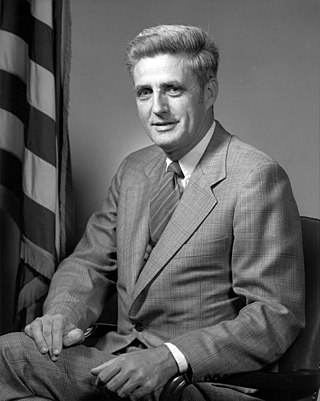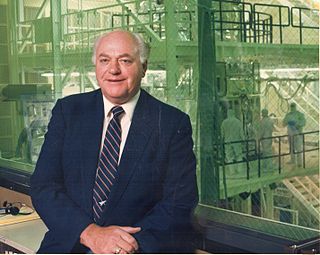Related Research Articles

Systems engineering is an interdisciplinary field of engineering and engineering management that focuses on how to design, integrate, and manage complex systems over their life cycles. At its core, systems engineering utilizes systems thinking principles to organize this body of knowledge. The individual outcome of such efforts, an engineered system, can be defined as a combination of components that work in synergy to collectively perform a useful function.

Simon "Si" Ramo was an American engineer, businessman, and author. He led development of microwave and missile technology and is sometimes known as the father of the intercontinental ballistic missile (ICBM). He also developed General Electric's electron microscope. He played prominent roles in the formation of two Fortune 500 companies, Ramo-Wooldridge and Bunker Ramo Corporation.

The V-model is a graphical representation of a systems development lifecycle. It is used to produce rigorous development lifecycle models and project management models. The V-model falls into three broad categories, the German V-Modell, a general testing model, and the US government standard.
Lockheed Martin Space is one of the four major business divisions of Lockheed Martin. It has its headquarters in Littleton, Colorado, with additional sites in Valley Forge, Pennsylvania; Sunnyvale, California; Santa Cruz, California; Huntsville, Alabama; and elsewhere in the United States and United Kingdom. The division currently employs about 20,000 people, and its most notable products are commercial and military satellites, space probes, missile defense systems, NASA's Orion spacecraft, and the Space Shuttle external tank.

Hans Michael Mark was a German-born American government official who served as Secretary of the Air Force and as a Deputy Administrator of NASA. He was an expert and consultant in aerospace design and national defense policy.

The International Council on Systems Engineering is a not-for-profit membership organization and professional society in the field of systems engineering with about 21,000 members and associates including individual, corporate, and student members. INCOSE's main activities include conferences, publications, local chapters, certifications and technical working groups.

Samuel Cochran Phillips was a United States Air Force general who served as Director of NASA's Apollo program from 1964 to 1969, as commander of the Space and Missile Systems Organization (SAMSO) from 1969 to 1972, as the seventh Director of the National Security Agency from 1972 to 1973, and as commander of the Air Force Systems Command from 1973 to 1975.

Gerald D. Griffin is an American aeronautical engineer and former NASA official, who served as a flight director during the Apollo program and director of Johnson Space Center, succeeding Chris Kraft in 1982.
Lawrence K. Edwards was an American innovator in aerospace and ground transportation. Early in his career, he pioneered technologies for U.S. space and missile defense programs. He went on to invent and promote high-speed Gravity-Vacuum Transit and monobeam rail transit. He obtained a total of fourteen patents in those areas.

Walter Barber LaBerge was an aerospace engineer and defense industry executive who served as United States Under Secretary of the Army from 1977 to 1980.
A brassboard or brass board is an experimental or demonstration test model, intended for field testing outside the laboratory environment. A brassboard follows an earlier prototyping stage called a breadboard. A brassboard contains both the functionality and approximate physical configuration of the final operational product. Unlike breadboards, brassboards typically recreate geometric and dimensional constraints of the final system which are critical to its performance, as is the case in radio frequency systems. While representative of the physical layout of the production-grade product, a brassboard will not necessarily incorporate all final details, nor represent the physical size and quality level of the final deliverable product.
Richard C. Scherrer (1919–2018) was an aircraft designer notable for pioneering work on revolutionary aircraft designs with extremely low radar cross sections that led to the Lockheed F-117 Nighthawk and Northrop Grumman B-2 Spirit.

Bertram Raoul Bulkin was an American aeronautical engineer who participated in the first United States photo-reconnaissance satellite programs and is best known for his role in building the Hubble Space Telescope.
INCOSE Pioneer Award is an annual prize for people who have made significant pioneering contributions to the field of Systems Engineering given by the INCOSE since 1997.
Harold (Hal) Mooz is an American systems engineer, business consultant and founder and CEO of The Center for Systems Management, Inc., awarded the INCOSE Pioneer Award in 2001.
Model-based systems engineering (MBSE), according to the International Council on Systems Engineering (INCOSE), is the formalized application of modeling to support system requirements, design, analysis, verification and validation activities beginning in the conceptual design phase and continuing throughout development and later life cycle phases. MBSE is a technical approach to systems engineering that focuses on creating and exploiting domain models as the primary means of information exchange, rather than on document-based information exchange. MBSE technical approaches are commonly applied to a wide range of industries with complex systems, such as aerospace, defense, rail, automotive, manufacturing, etc.

Andrew John Stofan is an American engineer. He worked for the National Aeronautics and Space Administration (NASA) at the Lewis Research Center. In the 1960s he played an important role in the development of the Centaur upper stage rocket, which pioneered the use of liquid hydrogen as a propellant. In the 1970s he managed the Atlas-Centaur and Titan-Centaur Project Offices, and oversaw the launch of the Pioneer 10 and Pioneer 11 probes to Jupiter and Saturn, the Viking missions to Mars, Helios probes to the Sun, and the Voyager probes to Jupiter and the outer planets. He was director of the Lewis Research Center from 1982 to 1986.

John R. Casani is an American engineer. He worked for the National Aeronautics and Space Administration (NASA) at the Jet Propulsion Laboratory, where he managed the Voyager, Galileo, Cassini and Prometheus projects.
References
- 1 2 Kevin Forsberg biography at incose.org. Accessed October 1, 2013
- 1 2 "INCOSE Pioneer Award". Archived from the original on 2007-04-17. Retrieved 2013-10-01.
- ↑ NASA SP. Scientific and Technical Information Office, National Aeronautics and Space Administration [available from National Technical Information Service, Springfield, Va. 1962. p. xii